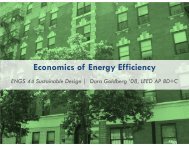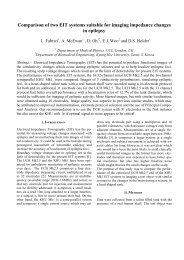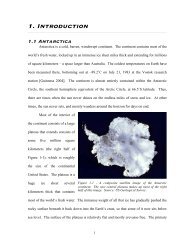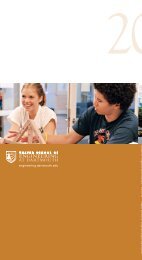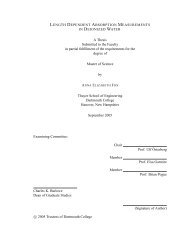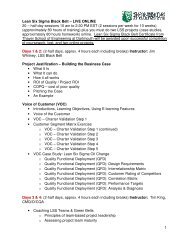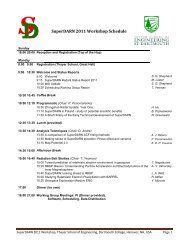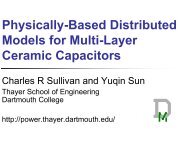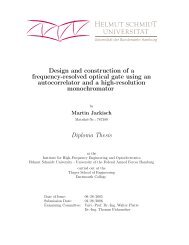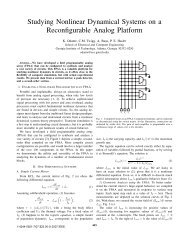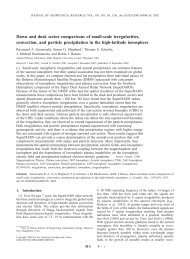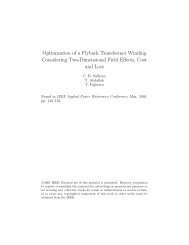Courses Programs - Thayer School of Engineering - Dartmouth ...
Courses Programs - Thayer School of Engineering - Dartmouth ...
Courses Programs - Thayer School of Engineering - Dartmouth ...
You also want an ePaper? Increase the reach of your titles
YUMPU automatically turns print PDFs into web optimized ePapers that Google loves.
graduate courses<br />
114<br />
ENGG 324 Microstrip Lines and Circuits<br />
(Cannot be used to satisfy any A.B. degree requirements)<br />
Offered: arrange<br />
Analysis <strong>of</strong> transmission structures and circuit elements at microwave frequencies.<br />
Microwave network representation. Characterization and sensitivities <strong>of</strong> transmission<br />
structure. Discontinuities. Two-dimensional planar components. Models for<br />
microwave semiconductor devices. Microwave networks.<br />
Prerequisites: ENGS 61, ENGS 105, ENGS 120, and permission <strong>of</strong> instructor<br />
Instructor: Trembly<br />
ENGG 332 Topics in Plastic Flow and Fracture <strong>of</strong> Solids<br />
(Cannot be used to satisfy any A.B. degree requirements)<br />
Offered: arrange<br />
Advanced study may be pursued on topics related to the microscopic aspects <strong>of</strong> the<br />
plastic flow and fracture <strong>of</strong> solids. The topics extend those introduced in ENGS 130<br />
and ENGS 132 by providing an in-depth examination <strong>of</strong> the methods <strong>of</strong> strengthening,<br />
brittle and ductile fracture, fatigue, creep, and superplasticity. The emphasis is<br />
on the mechanisms underlying the phenomena. Readings in the literature will be<br />
assigned, and the student will be required to prepare a detailed term paper.<br />
Prerequisites: ENGS 130, ENGS 132, and permission <strong>of</strong> instructor<br />
Instructor: Frost<br />
ENGG 339 Advanced Electron Microscopy<br />
(Cannot be used to satisfy any A.B. degree requirements)<br />
Offered: arrange<br />
Image formation and contrast are discussed for the transmission electron microscope,<br />
using both kinematical and dynamical theory. Image simulation methods are outlined<br />
and the information from a variety <strong>of</strong> diffraction methods, such as CBED, are<br />
described. Various analytical techniques such as electron energy loss spectroscopy<br />
and x-ray fluorescence, including advanced techniques such as ALCHEMI, are covered.<br />
Emphasis is placed on the applications, resolution, and theoretical and practical<br />
limitations <strong>of</strong> each technique. There are several laboratory sessions, each requiring<br />
a report.<br />
Prerequisite: ENGS 133 or permission <strong>of</strong> instructor<br />
Instructor: I. Baker<br />
ENGG 365 Advanced Biomaterials<br />
(Cannot be used to satisfy any A.B. degree requirements.)<br />
Offered alternate years: 12W: arrange<br />
This course will focus on the interface between the host and implant with greater<br />
emphasis on the tissue reaction to metals, ceramics, polymers, bioceramics, and<br />
biopolymers than on the effect <strong>of</strong> the host environment on the materials. Ion release<br />
concerns, wear particle reactions, and the potential toxic properties <strong>of</strong> the salts <strong>of</strong><br />
implant metals will be analyzed. The cells and cellular reactions available to the host<br />
will be evaluated in detail.<br />
Prerequisites: ENGS 165 and permission <strong>of</strong> instructor<br />
Instructor: Van Citters



